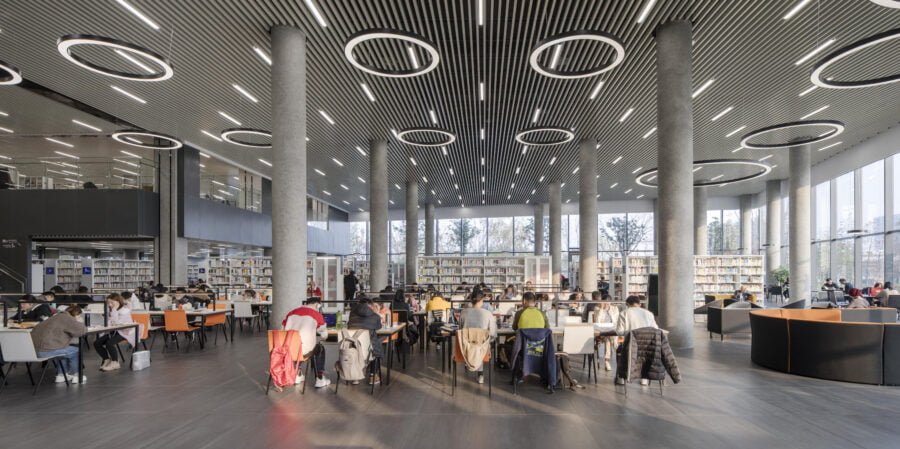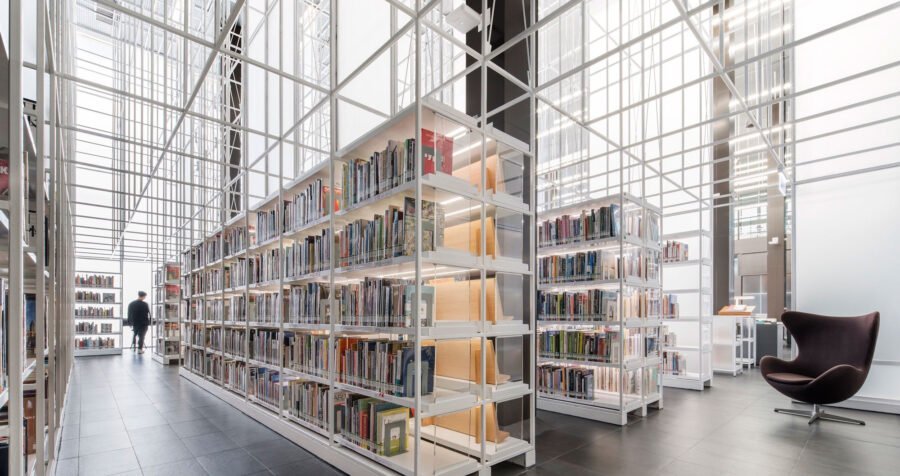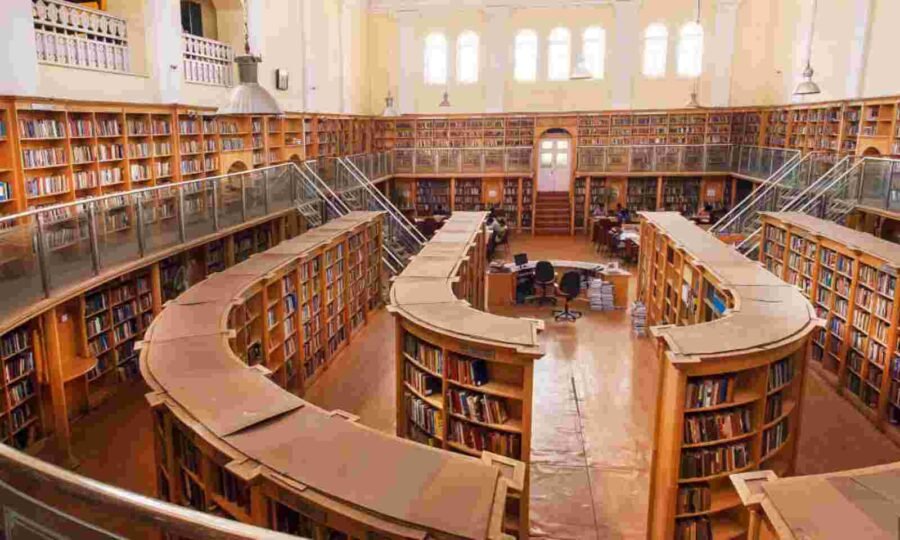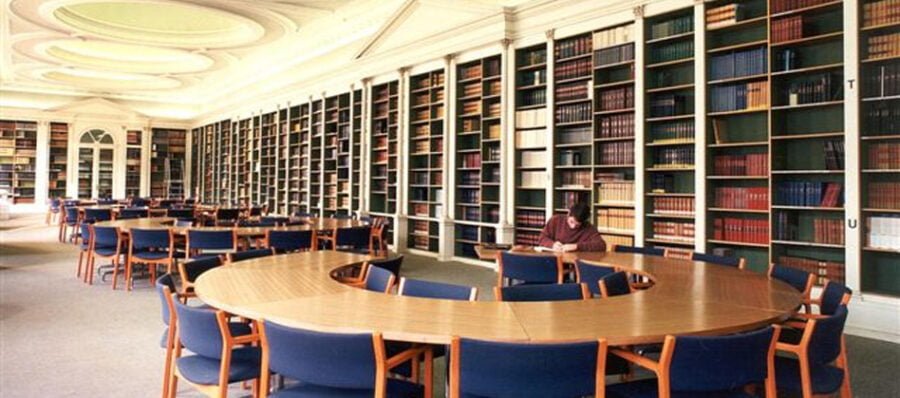The book has always been a symbol of poise and prestige; a statement of cultural distinction and personal value.

It is Wednesday, 14 August, 2024. I decided to write about refining my theories on the aura of Libraries for the nth time. Almost five thousand years ago, we know Ashurbanipal assembled the oldest known library and Asinius Pollio established the first public library, and the thought always kept fluttering over my head on how one could cage books within four walls. But, preserving libraries in a traditional yet evolved way is much more important than figuring out the freedom of books.
A caged human feels alive and free after becoming a part of reading culture. Reading became a transformative journey of self-awareness, illuminating life’s mysteries and intricacies. Visiting Libraries has always been a lot more than the act of reading itself. Library architecture design must consider both aesthetics and functionality to serve diverse user needs.
Most of the world’s population has shifted to the internet and digital library mediums where everything is available without any hustle and movement. Only a few book enthusiasts avid readers, and researchers were left to visit and make the libraries alive. Therefore, designers and artists came up with the vision to protect libraries at any cost as this has sometimes been the only source of their cultural representation.
Libraries began adapting as a third place. Apart from the traditional reading setup, the spaces emerged with a place for interaction, reading, discussing, and eating. Let me engage you with the diversity of libraries. The library architecture testing framework ensures the robustness of the systems implemented in digital libraries.
Table of Contents
The Diversity of Libraries

Incredible Architecture Libraries
National Libraries
The country establishes these libraries and guides the country’s cultural heritage. It contains important national resources, biographies, and access to research which holds the impression of being preserved by the Country. National libraries can hold books, digital copies, and computers for researchers. The Imperial Library of Kolkata is India’s largest library by public record.
Research Libraries
Research Libraries are curated with a collection of knowledge that holds importance to academic pursuits, research, and data collection. They can be in books, journals, articles, research papers, and archives. These have the sole purpose of contributing to research and educational backgrounds. The National Library of Malta in Valletta and the Sistine Hall of Vatican City are two prominent Research Libraries in the world.
School/University Libraries
These kinds of libraries are attached to universities and schools or any educational institution that provides material access to all the students and faculties of that or other institutions depending on the norms of that library. It contains all the material needed by students, and faculties for academic pursuits.
Public Libraries
The name itself describes that public Libraries are established for the common good, they’re easily accessible to the community and encourage reading and lending activities at minimal or no cost. These libraries are run and set up by state and local governments. Every state has at least one public library in the country which is accessible to every age-group citizen.

Digital Libraries
This type of library deals with a collection of digital materials such as e-books, videos, DVDs, audiobooks, lectures, and other digital resources. Examples of Digital Libraries include Internet Archives, Open Library, and Project Gutenberg. A library architecture thesis can explore the influence of modern technology on traditional library design.
Special Libraries
These specialized libraries have evolved as sanctuaries for rare and specialized collections, catering to the interests of specific communities. Many have their roots in the esteemed scientific and engineering societies of the 19th century, which sought to provide their members with exclusive access to cutting-edge knowledge and resources.

Let’s break the paradigm of our perspective towards Libraries and understand the need for Physical Libraries.
Public libraries have started adapting varyingly. The need for a library grew and is still growing as not every person has access to the digital world. Hence, books are reliable and cheap sources of qualitative data. To go and explore an entirely different world of book collection, digital sources cannot make you feel as good as one feels in the library in awe of books. Research has shown that people despite regional and social differences share a common interest in reading. Many private data, archives, and journals whose public and digital access is denied, we need a physical storehouse of those data.
Ill-maintenance, lack of funds, mundane infrastructure and buildings, and less access to the libraries resulted in a loss of public interest in the places.
Redefining Public Libraries in the World

Design Ideas for Public Libraries
Library can be a leisure place if they can be connected both internally as well as externally, even for non-readers. Open seating arrangements with lounge furniture – for merely interactive spaces with book stacks, to promote engagement and sociality. Libraries can have spaces for art forms, exhibitions, magazines, journals, interview spots, places for conferences, or organizing literary events.
The idea behind organizing literary events in the Library such that the place was flexible and adaptable to many ideas came from when I was in school. My school, Grand Columbus International School had a beautiful yet adaptable library space for reading, researching, and organizing events. Multi-purpose use of the space is which can make libraries attractive and satisfy modern solutions and needs.
Ray Oldenburg was a sociologist who coined the term ‘Third Place Theory’, in which he states that for a person, the third place should be a comforting and leisurely place where the person can relax away from home, but feels at home. The library architecture plan included several flexible study areas and multimedia zones.
Exploring Indian Libraries, we get a hint of the old aesthetics of a traditional library, where the building is swamped with book stacks and systematic seating with utter silence.
Public Library in India with traditional setting
Modern Libraries are slowly emerging a new definition of libraries where social engagement, discussions, involvement of cafes and exhibitions, and a leisure spot for people will evolve. For final projects, presenting a library architecture case study focusing on sustainable design is one of the best options.
Modern libraries evolving to multi-functional spaces
Incorporating Spaces through User’s Lens
In the 21st century, Libraries are effectively adapting according to the growing demands of readers following their needs and expectations. After the pandemic, COVID-19, the need for outdoor amenities has increased. Libraries should be designed as such designating more spaces for children, teens, and tweens.
The library should offer flexible as well as adaptable reading and learning environments for readers. It is a place where people from diverse backgrounds, age groups, and interests come to widen their knowledge and enrich their learning experience. Another is a Tech-hub for the latest digital technology access and a smooth Wi-Fi connection. The library architecture floor plan of the new university library features innovative learning spaces and quiet zones.
Along with Libraries, some basic and leisure requirements can be added to the list to make them more engageable, such as contemplative spaces, eating hotspots – and cafeterias. VMDO Architects in their research came up with awe-inspiring innovative spaces for the Modern transformation of Libraries. These are:
- Digital Media Common Rooms
- Adaptable to event space
- Library Staff
- Maker Spaces
- Traditional Reading Rooms
- Gathering spaces
- Browsing Rooms
- Outdoor Learning Spaces
- Conference Rooms
- Teen Service Rooms
Let’s explore a few interesting Libraries around the world known for their exquisite features and popularity among citizens.
Not Just Library
The Library was built on a heritage place, once a bathhouse for women working in a Tobacco company. Its main attractions include interactive open spaces, workstations, a museum, and appropriate spaces for art and design events and exhibitions.
Bath steps are used as shelves with LED Strip running over the seating
The Focused user groups for the Library were designers, artists, readers, photographers, and tourists of noisy Taipei City. The built area was 436 Sq.m. acquiring a Ground Floor and Garden for interaction and small gatherings. They have transformed a simple bathhouse into a marvel of literature. The library has a separate room provided for computer users with data access and a garden area with a coffee table and chairs.
The walls with mosaic are preserved to display the historic beauty. The library has its busy hours from 12 pm to 6 pm with Saturdays most, and Mondays as holidays.
Sweet Briar College Cochran Library
Sweet Briar College Library in Cochran, VA
Ralph Adams Cram constructed the Cochran Library in 1927. The site location and orientation of the Library building make it a perfect blend of the architect’s vision and the reader’s requirements. The natural light felicitates the entire reading space and gives readers an outside view of the building.
It’s a beautiful work of modern approach mixed with traditional elements such as materials used in the facade and interior of the building including cast stone masonry, brickwork, and large glass windows. The Library building consists of an enlarged reading space, a room for books, open space for gathering and discussion connected inside by a vaulted gallery of arches.
Reading Hall of Cochran Library
The Cochran Library addition and renovation, culminating from a decade of partnership, sought to harmoniously blend preservation and innovation, respecting the library’s esteemed heritage and loyal alumnae, while embracing the evolving needs of modern learning spaces.
The Book Room
Cultural Library Cafe of Pune, built-in 2020
In an area of 940 sq.ft, The Book Room is well established as a small double-height spacious library with a small courtyard and parking lot. It is a must-have place for readers and youths as well as adults who love being there among books and food. The place is built up in levels depicting a tremendous roller-coaster journey when a person enters a journey through the book.
Stepped informal seating as a multi-utility learning space
Libraries have been both comforting and knowledgeable places at the same time. To enrich visitor’s experience, the cafe used subtle earthly and light tones to make the space more humane. The material and texture palette comprises brick, concrete, and eco-friendly plywood. The interior is surrounded by greenery by maximum use of indoor plants which also keeps the building cool most of the time.
The Book Room has ample space for public interaction, seminars, and author events, and also a work area with informal seating. Bookshelves are provided on the walls to maximize the space.
Furniture such as chairs, bookshelves, and reading tables were also chosen such that it integrates with the texture of the reading area to provide a soothing effect to readers. A perfect third place for today’s world. A communal reading area, situated at the far end, is intentionally crafted to encourage dialogue, spark conversations, and facilitate the cross-pollination of ideas among people from varied backgrounds, promoting a sense of community and collective discovery.
Use of Earthly tones and a subtle colour palette to make the space more humane
Cotia Library Garden
This private library’s design originated from a bibliophile’s desire to transform a hidden book collection, previously tucked away in boxes, into a beautifully organized and displayed space. The design process entailed a thoughtful conversation between the established habits of the existing home and the vast potential of the adjacent garden, aiming to create a seamless fusion. It was completed in 2016 within a small area of 104 Sq.m.
There were two entity volumes which were separated by a generous garden and a balcony. The project has several openings and each opening is determined by a different purpose.
The transparency added invites the morning sun in winter and hides it in summer. The East facade is covered with horizontal blinds allowing minimal sun for light landscaping.
North and South facades of the library aim at a visual contact with the existing house
The library’s inner spaces are crafted through a thoughtful balance of openings and defined by the central double-brick wall, which provides structural support. The toilet, the most secluded space, acts as a solid foundation for the hybrid structure of wooden pillars and masonry. In contrast, the reading balcony offers an expansive and airy atmosphere, perfect for quiet contemplation and reading beneath the tree’s protective shade.
It is also known as the Garden Library. This is designed in the context of residence for people of that residency/house. It proposed a dialogue between daily habits cultivated in a pre-existing house and a large garden area available.
Exploring various libraries with distinct features and attractions sets them apart from other libraries that are not maintained or don’t adapt according to modern needs.
Third-place theory is a generalized idea that can be applied to any space, which can emphasize a space leading to innovation, new experiences, and social involvement.
Above through various examples, we saw the inclusion of cafes, and outdoor green spaces for gathering added strength to the library, for even non-book readers to at least try the experience of going to the library which can add a new dimension to their thoughts.
Incorporating some needful spaces- open, semi-open, and closed spaces, as per the users will add a new life to the libraries.




